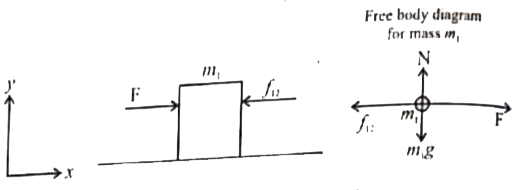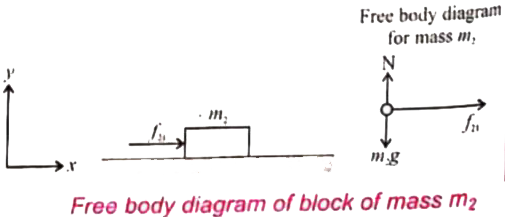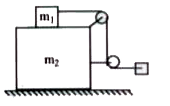Two blocks of masses m1 and m2(m1>m2) in contact with each other on frictionless, horizontal surface. If a horizontal force F is given onm1 set into motion with acceleration a, then reaction force on mass m1 by m2 isSolution in Tamil
Let us consider two blocks of masses m1 and m2(m1>m2) . Kept in contact with each other on a smooth horizontal frictional surface as shown in the figure

By the application of a horizontal force F both the blocks are set into motion with acceleration a simultaneously in the direction of the force F .
To find the acceleration →a Newton's second law has to be applied to the system mass m=m1+m2
If we select the motion of the two masses along the positive x direction Fˆj=maˆi
The acceleration of the system is given by
∴,a=Fm1+m2
The force exerted by teh block m1 on m2 due to its motion is called force of contact (fn) According to Newton's third law the block m2 will exert an equivalent opposite reaction
Figure shows the free body diagram of block m1

Fˆi−f12ˆi=m1aˆi
By comparing the components of the above equation we get
F−f12=m1a
f12=F−m1a
Substituting the value of acceleration from equation (1) in (2) we get
f12=f−m1Fm1+m2
F12=Fm2m1+m2
Equation (3) shows that the magnitude of contact force depends on mass m2 which provides the reaction force . Note that this force is acting along the negative x direction m1 is given by f12=−Fm2m1+m2
For m2 there is only one force force acting on it the x direction and it is denoted by f21 . this force is exerted by mass m1 .the free body diagram for mass m2 is shown in the figure .

Applying Newton' second law for mass m2
f21ˆi=m2ˆi
By comparing the components on both sides of the above equation
f21=m2a
Substituting for acceleration from equation
(1) in equation (4) we get
f21=Fm2m1+m2
In this case the magnitude of the contact force is f21=Fmm1+m2
Similar Questions
In the arrangement shown in the figure all surfaces are frictionless, the masses of the block are m1=20kgandm2=30kg. The accelerations of masses m1andm2 will be if F = 180N.

View SolutionTwo bodies of masses m1 and m2 are separated by certain distance. If →F12 is the force on m1 due to m2 and →F21 is the force on m2 due to m1 , then
View SolutionGravitational force between masses m1 and m2 is F. If a third mass m3 is placed near m1 and m2, then the force between m1 and m2 would be
View SolutionTwo bodies of masses m1andm2 are separated by certain distance. If →F12 is the force on m1 due to m2and→F21 is the force on m2 due to m1 then
View SolutionGravitational force between masses m_1 and m_2 is F. If a third mass m_3 is placed near m_2 and m_3 then the force between m_1 and m_2 would be
View Solutionm1 तथा m2(m1>m2) द्रव्यमान के दो कणों A1 तथा A2 की दे-ब्रॉग्ली तरंगदैर्घ्य समान हैं। तब-
View SolutionThe mass of m2 was reduced to 50% and the force exerted by m1on m2 is 20 N. what is the force exerted by m2on m1?
View SolutionThree blocks of masses m1,m2and m3kg are placed in contact with each other on a frictionless table. A force is applied on the heaviest mass m1, the acceleration of m3 will be:
View Solution

